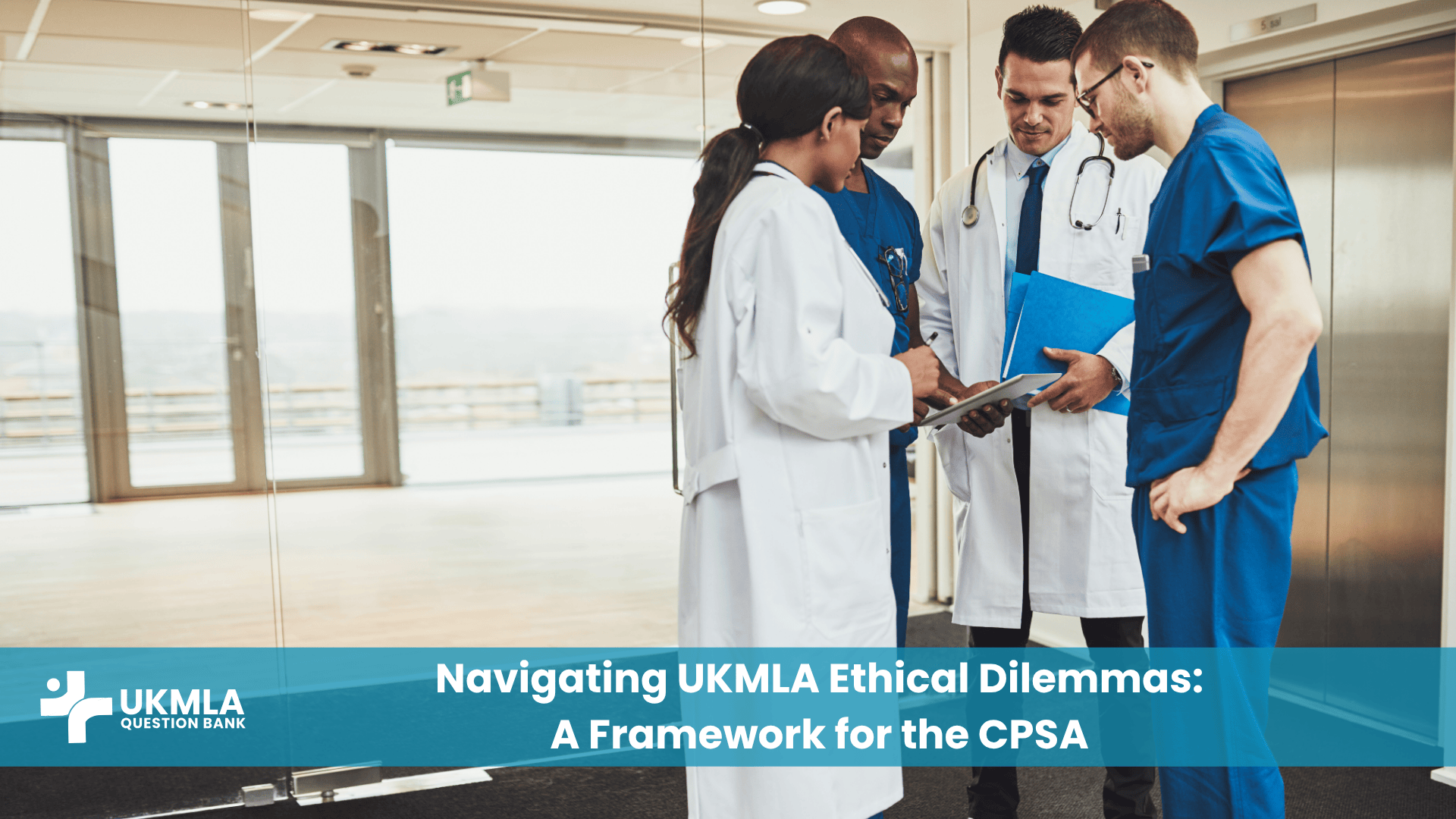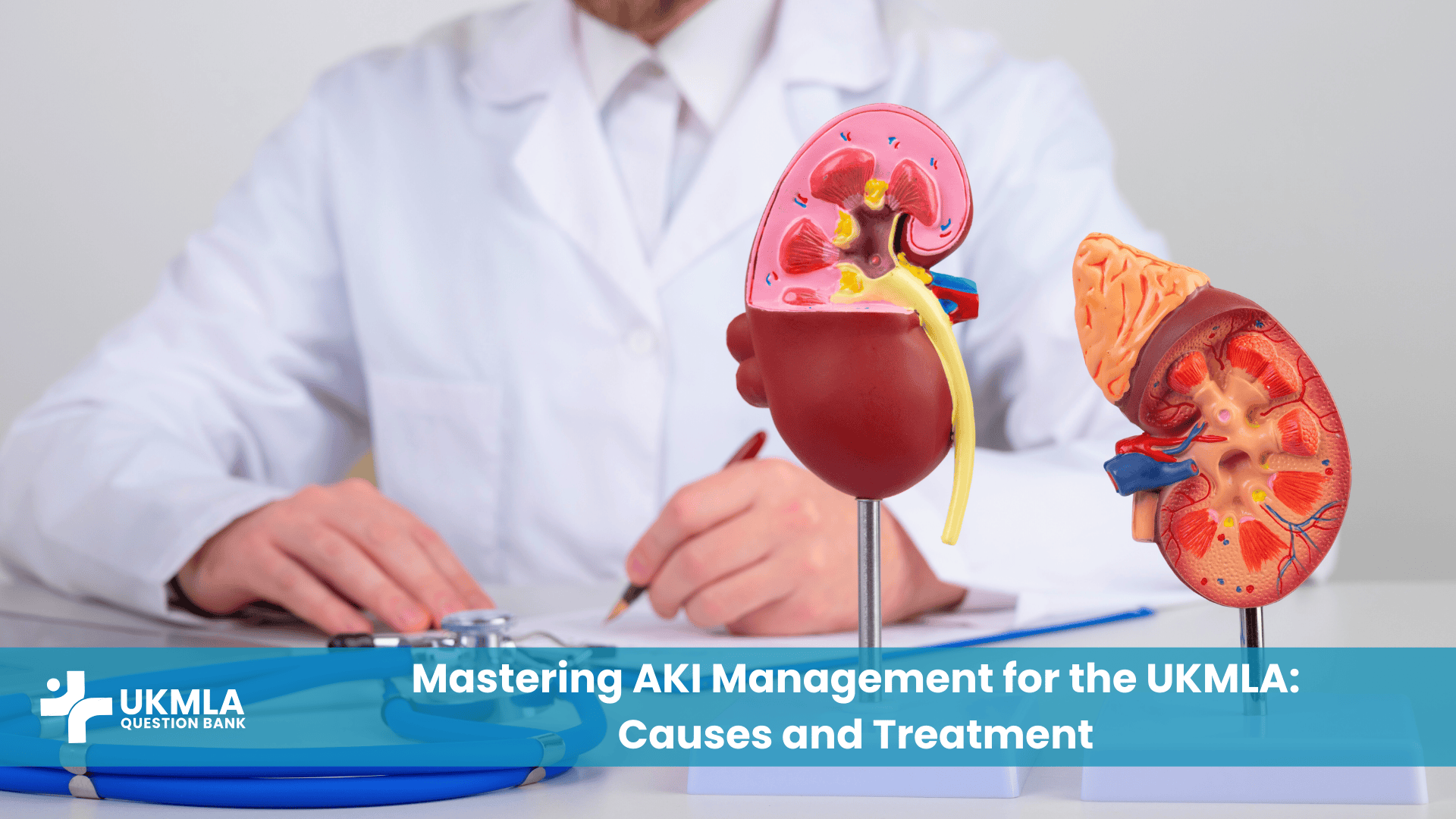Introduction
Navigating UKMLA ethical dilemmas is a core challenge of the Clinical and Professional Skills Assessment (CPSA) and a true test of your readiness for UK practice. Unlike questions with a single correct answer, ethics stations assess your reasoning, your communication skills, and your ability to apply foundational principles to complex, real-world scenarios. It’s an area that can cause significant anxiety, as there often isn’t a perfect solution, only a well-justified and defensible one.
This guide is designed to replace that anxiety with confidence. We will move beyond simply knowing the rules and provide you with a robust framework for deconstructing any ethical scenario you might face. By understanding the core pillars of medical ethics, knowing your key GMC guidance, and applying a structured 4-step approach, you can learn to articulate a safe, patient-centered, and highly professional response every time.
Table of Contents
ToggleThe Foundation: The Four Pillars of Medical Ethics
Before tackling any scenario, you must have the four pillars of medical ethics at the forefront of your mind. They provide the universal foundation for your reasoning.
Beneficence (Acting in the patient’s best interest)
This is the principle of actively doing good. It’s not just about providing treatment, but about ensuring your actions are aimed at promoting the patient’s health and well-being. In a scenario, you should always be thinking: what course of action will lead to the best possible outcome for this patient?
Non-maleficence (Do no harm)
This is the corollary to beneficence. It is the duty to prevent and avoid causing unnecessary harm. This includes not only physical harm but also psychological distress. When considering your options, you must weigh the potential harms of each choice against its potential benefits. Sometimes, the least harmful option is the most ethical one, even if it doesn’t provide a perfect resolution.
Autonomy (Respecting the patient’s choices)
This principle recognizes that competent adult patients have the right to make their own informed decisions about their medical care, even if those decisions seem unwise to the medical team. This involves ensuring the patient has the capacity to make the decision and has been given all the necessary information to do so. A significant part of demonstrating this principle is exploring the patient’s reasoning, beliefs, and values.
Justice (Fairness and equity in care)
Justice in a medical context refers to the fair distribution of health resources and the equitable treatment of all patients. On a micro-level, this means treating patients without bias or prejudice. On a macro-level, it can involve considering the impact of your decisions on the wider community or healthcare system, such as the allocation of scarce resources.
Your Toolkit: Core GMC Guidance
While the four pillars provide the philosophical framework, your actions as a future UK doctor are governed by the General Medical Council (GMC). Referencing their guidance is essential in any ethics station. This is a core part of the medical ethics and law for the UKMLA.
Good Medical Practice: The Cornerstone Document
The GMC’s Good Medical Practice is the single most important document. It sets out the principles, values, and standards expected of every doctor practicing in the UK.
Key GMC Principle: “As a doctor, you have a duty to make the care of your patient your first concern.” (Domain 1: Knowledge, skills and performance)
Being familiar with the four domains of Good Medical Practice (Knowledge, skills and performance; Safety and quality; Communication, partnership and teamwork; Maintaining trust) allows you to structure your thinking and response. A focus on UKMLA professionalism and patient safety is central to this.
Confidentiality: A Doctor’s Duty of Trust
The GMC places a very high value on patient confidentiality. You must not disclose a patient’s personal information unless you have their explicit consent or there is a compelling legal or public interest justification (e.g., safeguarding a child or preventing serious harm).
Consent: The Principles of Shared Decision-Making
Valid consent must be voluntary, informed, and given by a person with the capacity to make the decision. The GMC promotes a model of shared decision-making, where the doctor and patient work together to choose a course of action. For complex situations, you may need to refer to official guidance, such as the NICE guidance on decision-making and mental capacity.
A 4-Step Framework for Tackling ukmla ethical dilemmas
When faced with a CPSA ethics station, it’s easy to panic. This simple 4-step framework will keep you grounded and ensure you cover all the key domains.
Table 1: The 4-Step Framework for Ethical Scenarios
| Step | Action | Key Questions to Ask Yourself |
| 1. Identify | Identify the core dilemma and all stakeholders. | Who is involved? What are the competing interests? What is the central conflict? |
| 2. Apply | Apply the ethical pillars and relevant GMC guidance. | Which pillars are in tension? What does GMC’s Good Medical Practice say? |
| 3. Explore | Explore all viable options and their consequences. | What could I do? What are the pros and cons of each option for each stakeholder? |
| 4. Justify | Formulate and clearly justify your chosen action plan. | What will I do now? What will I do next? How can I justify this decision? |
Step 1: Identify the Core Dilemma and Stakeholders
First, take a moment to summarize the situation in your head. What is the central ethical conflict? For example, is it a clash between patient autonomy and your duty of beneficence? Then, identify everyone involved (the stakeholders): the patient, their family, you, your senior colleagues, other healthcare professionals, and sometimes even the wider community.
Step 2: Apply the Ethical Pillars and GMC Guidance
Explicitly work through the four pillars. State which ones are relevant and how they apply to the situation. For example, “In this situation, the principle of patient autonomy is in conflict with the principle of non-maleficence.” Then, bring in the GMC. “GMC guidance on confidentiality is central here, but I also have a duty to consider the safety of others.”
Step 3: Explore All Viable Options and Their Consequences
Discuss the different paths you could take. It’s crucial to show the examiner you have considered multiple options, not just jumped to a conclusion. For each option, briefly outline the potential positive and negative consequences for the different stakeholders involved.
Step 4: Formulate and Clearly Justify Your Action Plan
Finally, state what you will do. Be clear and specific. Your plan should involve immediate actions (“First, I would ensure the patient is stable…”) and subsequent steps (“Next, I would discuss the situation with my educational supervisor…”). Justify your choice by referencing the ethical pillars and GMC guidance you have already discussed. This demonstrates a safe, logical, and professional thought process, which is the key to passing challenging scenarios for the UKMLA CPSA.
Common UKMLA CPSA Scenarios: Worked Examples
Let’s apply the framework to a few classic scenarios. These are simplified examples; in the exam, you would expand on each step. The UKMLA CPSA explained guide can provide more context on the station format.
Scenario 1: The Underage Patient Requesting Confidential Advice
A 15-year-old patient asks for the contraceptive pill and begs you not to tell their parents.
1. Identify: The dilemma is respecting the patient’s confidentiality versus the parents’ potential role and your duty to a minor. Stakeholders are the patient, the parents, and you.
2. Apply: Autonomy (of the Gillick-competent minor) vs. Beneficence (ensuring they are safe). GMC guidance on confidentiality is paramount.
3. Explore: Option A: Prescribe and tell no one. Pro: respects autonomy. Con: misses potential safeguarding issues. Option B: Refuse to prescribe without parental consent. Pro: simple. Con: breaks trust, patient may engage in unsafe sex. Option C: Assess for Gillick competence (Fraser guidelines) and explore the reasons for secrecy.
4. Justify: “My immediate action would be to assess the patient’s competence using the Fraser guidelines in a private, non-judgemental consultation. If they are competent, I have a duty of confidentiality. I would gently encourage them to speak to their parents but would not force them. I would also need to sensitively screen for any safeguarding concerns.”
Scenario 2: The Competent Adult Refusing Life-Saving Treatment
A Jehovah’s Witness with a massive gastrointestinal bleed is refusing a life-saving blood transfusion.
1. Identify: The dilemma is the patient’s autonomous refusal versus the team’s strong duty of beneficence to save their life. Stakeholders are the patient, their family (who may agree or disagree), the medical team.
2. Apply: Autonomy is the key principle. A competent adult has the right to refuse treatment, even if it leads to their death. This clashes directly with Beneficence.
3. Explore: Option A: Give the blood anyway. This is assault and illegal. Option B: Accept their refusal. This respects autonomy but results in death. Option C: Ensure the patient has capacity, has been fully informed of the consequences of their refusal, is not being coerced, and explore all possible alternative treatments (e.g., blood products they might accept).
4. Justify: “My priority is to formally assess the patient’s capacity to make this decision. If they have capacity, I must respect their autonomy. I would ensure they fully understand that refusing blood will likely result in their death. I would involve a senior consultant and explore all possible management alternatives with the patient. I would document this conversation meticulously.”
A Deeper Dive into Confidentiality Scenarios
While the scenarios above cover key dilemmas, confidentiality itself presents a unique and frequent challenge in the CPSA. Here are two more high-yield, tricky situations and how to apply the 4-step framework.
Worked Example: The Police Request for Information
The Scenario: You are the junior doctor on a surgical ward. A police officer approaches you and asks for information about a patient who was admitted yesterday after being stabbed, stating it is for a serious criminal investigation. The patient is currently off the ward having a CT scan.
Breakdown using the 4-Step Framework:
Identify: The core dilemma here is your duty of confidentiality to the patient versus the public interest in allowing the police to investigate a serious crime. The stakeholders are the patient, the police officer, you, and the hospital trust.
Apply: GMC guidance on “Confidentiality” is paramount. It states that you should usually seek a patient’s consent before disclosing information. However, it also allows for disclosure without consent if it is required by law or is in the public interest. The police do not have an automatic right to access medical records without a legal basis.
Explore:
Option A: Refuse to provide any information. This upholds your duty of confidentiality but is unhelpful and may obstruct a serious investigation.
Option B: Provide the information requested. This breaches your duty of confidentiality without the patient’s consent and without a clear legal mandate, potentially exposing you to legal and professional consequences.
Option C: Engage professionally, explain your duties, and clarify the legal basis for the request. This is the correct approach. It respects both your duty to the patient and your responsibility to assist legal processes where appropriate.
Justify: Your action plan should be clear and professional. “My immediate action would be to politely explain to the officer my duty of confidentiality. I would state that I cannot release information without patient consent or a formal court order. I would offer to ask the patient for their consent as soon as they are well enough to discuss it. If the officer were to present a warrant, I would then consult with my senior consultant or the hospital’s legal department before providing the specific information requested.”
Worked Example: The Unfit Driver and the DVLA
The Scenario: You are in a GP clinic reviewing a 65-year-old taxi driver who has just been diagnosed with poorly controlled epilepsy. You explain to him that he has a legal duty to inform the DVLA and must stop driving. He becomes angry, stating he will lose his livelihood and his home, and he refuses to inform the DVLA. He tells you he intends to continue driving.
Breakdown using the 4-Step Framework:
Identify: This is a classic conflict between your duty of confidentiality to the patient and your duty to protect the public from serious harm. The stakeholders are the patient, you, the DVLA, and the wider public (pedestrians and other road users).
Apply: This is one of the most well-defined areas of public interest disclosure. The GMC provides specific step-by-step guidance on this exact scenario. The key principle is that public safety can override patient confidentiality if a patient who is unfit to drive continues to do so.
Explore:
Option A: Do nothing and respect the patient’s confidentiality. This is unsafe and professionally negligent, as you would be knowingly allowing a significant risk of serious harm to the public.
Option B: Inform the DVLA immediately without telling the patient. This addresses the public safety risk but breaches the trust between you and the patient.
Option C: Follow the GMC’s graduated and transparent approach. This is the correct and defensible action.
Justify: Your action plan must follow the official guidance. “My action plan would follow the GMC’s specific guidance. I would first counsel the patient on the importance of informing the DVLA and the risks to public safety. I would try to persuade them to self-report and document this conversation clearly. If they still refuse and I believe they will continue to drive, I would inform them of my intention to breach confidentiality in the public interest and then contact the DVLA myself.”
Frequently Asked Questions (FAQ) about UKMLA Ethical Dilemmas
This is the basis of most dilemmas! There is no magic formula. The key is to acknowledge the conflict explicitly, weigh the principles against each other in the context of the specific situation, and justify why you are prioritizing one over the other.
These are criteria to determine if a person under 16 is “Gillick competent” to consent to contraceptive advice. You must be satisfied that the young person understands the advice, cannot be persuaded to inform their parents, is likely to continue having intercourse with or without contraception, and their physical or mental health is likely to suffer unless they receive the advice or treatment.
Use active listening, acknowledge the patient’s feelings (“I can see this is very distressing for you”), use open body language, and avoid jargon. Empathy is about understanding and validating their perspective, even if you don’t agree with it.
It is much better to say, “This is a complex situation, and I am not sure of the exact legal next step. My immediate action would be to ensure the patient is safe, and then I would immediately seek advice from my senior consultant and the hospital’s legal team” than to guess and be wrong. This shows safety and an understanding of your own limitations.
You are not expected to be a lawyer, but you should understand the core legal principles related to capacity (Mental Capacity Act in England & Wales), consent, and confidentiality.
Your primary duty is to the patient. If the patient has capacity, their wishes are paramount, even if the family disagrees. You should listen to and be empathetic with the family, but gently explain that you must respect the patient’s autonomy.
Spend the first 1-2 minutes thinking and structuring your answer with a framework. Spend the next 5-6 minutes explaining your reasoning, working through your framework, and discussing your action plan. Leave a minute at the end to summarize your key points.
Usually not. There are, however, “wrong” and “unsafe” answers. The examiners are testing your thought process. A safe, well-justified answer that shows you’ve considered the key issues will pass, even if another candidate chose a slightly different (but still justifiable) course of action.
It is just as important as your ethical reasoning. You must be able to articulate your thoughts clearly, professionally, and empathetically. Practice talking through scenarios out loud.
The GMC website has many case studies. Question banks designed for the UKMLA and PLAB 2 are also excellent sources of realistic scenarios.
Conclusion
Ethical dilemmas are an unavoidable and challenging part of medical practice. For the UKMLA CPSA, the goal is not to find a perfect, magical solution, but to demonstrate a thought process that is safe, systematic, and deeply rooted in the core principles of UK medical practice. By internalizing the four pillars of ethics and the key guidance from the GMC, you can build a strong foundation for your reasoning.
Using a structured framework in the exam will prevent you from panicking and ensure you address all the critical domains. Practice applying this framework to various scenarios until it becomes second nature. This preparation will not only enable you to pass the CPSA but will also equip you with the confidence to handle the real-life ukmla ethical dilemmas you will face as a junior doctor.



